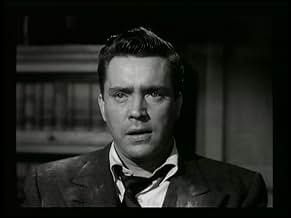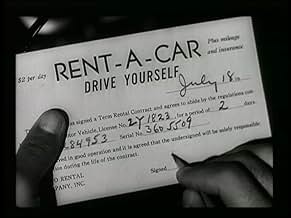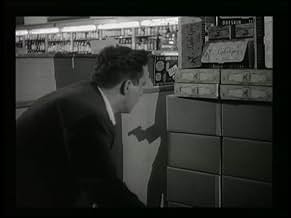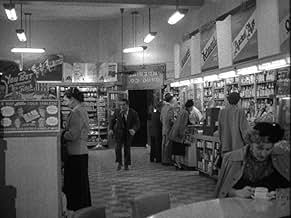Frank Bigelow, qui apprend qu'il a été empoisonné et qu'il ne lui reste que quelques jours à vivre, tente de découvrir qui l'a tué et pourquoi..Frank Bigelow, qui apprend qu'il a été empoisonné et qu'il ne lui reste que quelques jours à vivre, tente de découvrir qui l'a tué et pourquoi..Frank Bigelow, qui apprend qu'il a été empoisonné et qu'il ne lui reste que quelques jours à vivre, tente de découvrir qui l'a tué et pourquoi..
- Réalisation
- Scénario
- Casting principal
- Récompenses
- 2 victoires au total
- Miss Foster
- (as Beverly Campbell)
- Sue
- (as Cay Forrester)
- Dr. Matson
- (as Fred Jaquet)
- Dr. Schaefer
- (as Larry Dobkin)
- St. Francis Hotel Desk Clerk
- (non crédité)
Avis à la une
Anyhow, don't let those sappy early scenes fool you. They're necessary to set up the contrasting downspiral that ensues. As it happens, Frank Bigelow (O'Brien) may be bored with his accounting job in a quiet little town, along with the prospects of marrying a conventional girl, Paula (Britton), and living out a routine existence there. So, at the first chance there he goes, off to enjoy adventures in the big city, even if only brief ones. And get a load of the available women swarming around his San Francisco hotel. Now that adventure beckons, it's no longer thoughts of Banning or Paula. (But what was musical arranger Tiomkin thinking with those utterly cartoonish wolf whistles, perhaps the movie's only flaw).
So, along with the goodtime gang he's hooked up with, it's off to wild nightspots for the suddenly footloose Bigelow. The trouble is Frank has taken a big step away from the ordered simplicity of his small town and into the unfamiliar world of chaotic city life. And worse, the frenzied chaos of The Fisherman, its strung-out patrons and aggressive atmosphere, clouds the fact that his life will never be the same. In fact, the jazz scene with it's blaring, chaotic close-ups amounts to a superb one-of-a-kind metaphor for the bizarre world the small town accountant has now entered. Just as importantly, it makes anything that happens thereafter seem weirdly possible. As a result, when Frank swallows what turns out to be a deadly neon toxin, it seems perfectly in keeping with this landscape of disorder.
I may be biased, but O'Brien really deserved at least an Oscar nomination for his energetic and nuanced performance, as though Hollywood ever rewarded low-budget B-movies. In fact, I'm ready to enter him in the Olympics, for that 500-yard mad dash down Market Street. What a great natural reaction to the news that he's already a dead man. And filming the sequence with, I suspect, a hidden camera adds a kind of realism to the convoluted remainder of the whodunit.
Another high point is the sequence with the psychotic Chester (Brand). What a great piece of casting. Brand has such distinctive features, which he twists to full effect on the tormented Bigelow. But little does he know that Frank has acquired a peculiar kind of power. After all, what does he need to be afraid of since he's already dead. That scene in the drug store where Chester overplays his hand is another piece of fine filming and staging. I wouldn't be surprised that many in the audience have speculated with what they would do with Frank's kind of power, heavily purchased though it is.
What's so amazing about the movie is how adeptly the theme builds right down to the inevitable climax. We begin with a glimpse of a well-ordered world, but one that quickly descends into the depths of chaos and disorder, as Bigelow travels a nightmare road in pursuit of the where and why of his killer. I take the moral to be a conservative one, something like appreciating the routine and conventional, since it's never certain when an uncaring fate might intervene. After all, Frank really only comes to appreciate Paula and his small town once he's experienced its opposite. It's something that could happen to any of us, since even the most routine act may have unforeseen consequences. That's what's so unsettling about the movie.
Anyway, it's hats off to everyone involved in the making of this memorable noir. It's one of those submerged classics like Invasion of the Body Snatchers (1956) that surfaced only after a period on late night TV. Frankly, I still sometimes slip it out late at night, and pull up my socks real tight. To me, it's got that kind of staying power.
(In passing—living in LA, I occasionally pass the Bradbury Building and think of the movie. It looks pretty much the same as it did then, but has since acquired a kind of cachet among movie makers. I like to think it's because of the sweaty, underrated Eddie O'Brien and the unforgettable Frank Bigelow.)
It took a while for Bigelow to realize that he had a fatal dose of luminous toxin in his system and by the time he did it was too late to save his life. But it wasn't too late for Bigelow to track down and find the person or persons who had him poisoned. And it's during the rest of the movie, in flashback, that's exactly what he did! And did it with an unrelenting fury as if his life depended on it!
In what is undoubtedly Edmound O'Brien's best role as Frank "Biggie" Bigeow the film "D.O.A" has him move heaven and earth to find the person who eventually murdered him. From San Francisco to Los Angeles as well as parts in between Bigelow finally track him down to the Philips Inport-Export office at the Bradbury Building in downtown L.A. It in fact was Philips who was murdered, by being thrown to his death, because of the illegal iridium shipment that he later realized he was tricked into handling. With Philips dead the only person who could connect both his murderer and the person whom he shipped the iridium for is Frank Bigelow who handled, by notarizing the bill of sale, the shipment!
Non stop action thriller as a dying, or murdered, man turns L.A upside down in trying to find his killer and exact punishment on him before he himself expires! Bigelow also gets involved with L.A mobster Majak, Luther Adler, whom the illegal iridium was delivered for. In knowing about Majak's involvement in it had Bigelow targeted by him and his sadistic and unstable hit man Chester, Naville Brand, for immediate termination. That's if the luminous toxin doesn't kill him first!
Even though the movie is a scant 83 minutes long it packs enough action to fill some half dozen films of it's type: Film Noir Thrillers. Frank Bigelow is a man who knows that he hasn't long to live and therefore throws caution to the wind in trying to find his killer before the curtain comes down on him. It was in fact that almost suicidal determination on Bigelow's part that in the end brought him results!
This brings me to D.O.A., directed by Rudolf Maté. D.O.A. in my book is the Citizen Kane of the noirs. It's so good that I often wonder about how it got made in the first place. Since many of the people who were involved in its production are now no longer with us, I may never learn anything about its origins. That's a frustration, of course, but the more important thing is that I can recognize a great noir when I see it.
Why, you ask, is D.O.A. a great noir? The most obvious reason is its plot. A guy goes out for a night on the town and someone, a total stranger, slips him a mickey in a bar-a lethal mickey. But it doesn't kill him instantly. It kills him slowly, so slowly that he's given the chance to find out who did this terrible thing to him, and why.
Second, the film is exceptionally well made in every other respect. Okay, the Pamela Britton character is one dimensional and embarrassing, we all agree on that, but who really cares when everything else in the film is so good? Edmond O'Brien had one of the best roles of his career in D.O.A., and he took full advantage, though few critics give his performance much credit for the film's success.
O'Brien, a classically trained actor, plays a small-time Southern California businessman living his ordinary little life, minding his own business, regularly boffing his secretary (this was implied rather than made explicit; after all, this was 1949), and avoiding her whiney entreaties that they tie the knot, as he's been promising her he would do for ever so long.
You can't help liking O'Brien in part precisely because of his human flaws. He's basically decent, but harassed, overworked, and stretched to the limit by the pressure put on him by Britton. What adult male couldn't identify with this man, or at least sympathize? His very insignificance as one more human ant on the planet Earth, and the terrible thing that's about to happen to him, are the essence of great film noir. (Detour, although by no means a favorite noir of mine, is nevertheless another perfect example of an ordinary man, a small-timer, minding his own business and unexpectedly colliding with Fate and all that it has in store for him.) We resonate to D.O.A. because fate and contingency have been the fundamental conditions of life on the planet earth since before the beginning of history. Our time on Earth is brief and our lives but little scraps of paper blown about by the wind toward endings we know not. We live noir lives.
The film's particulars are wonderful. From the sunny hick town of Banning, the movie switches quickly to San Francisco. If ever there were a noir town, it's Frisco. (Hitchcock picked up on that real quick; watch Vertigo again to see how he saw the eerie side to that town, with its creepy deserted streets, little ghostlike fog-blown urban hills, and other abandoned places suggestive of loneliness and soullessness.)
From here one great noir scene follows another in astonishing succession: the smoky, crowded jazz bar where the sweaty black musicians are blowing up a storm (to an all-white 1949 audience of course), while a murder is silently committed with a switched drink. The doctor holding the eerily glowing glass tube of luminescent poison and informing O'Brien, "You've been murdered." O'Brien running through the crowded downtown streets like a madman, as if velocity could help him escape his fate. O'Brien, after being shot at, a gun now in his own hand, looking for his killer in the abandoned processing plant. His encounter with Luther Adler's insane, sadistic henchman played by Neville Brand. Brand, speaking softly, glints of spittle in the corners of his mouth, nutty little eyes lighting up with anticipated pleasure: "I'm gonna give it to you in the belly. You're soft in the belly, aren't'cha? " Then the fantastic night scene in the crowded Los Angeles drugstore with Brand stalking him among oblivious customers-till shots ring out, then screams, followed by death. Finally, again at night, O'Brien's confrontation with his killer, which (inevitably) occurs in the Bradbury Building, that great architectural shrine to noir, scene of so many other noir films.
Let's stop for a moment and go back to an earlier part of the film. Fatally poisoned, still not quite believing what has happened to him, exhausted and uncertain of anything, O'Brien has run for block after block, but now his energy has finally petered out and he finds himself alone near the docks. Utterly depleted, all hope lost, he wearily leans against the side of an old wooden newsstand in an otherwise bleak, abandoned area. Eyes glazing over, he's terrified, trying to catch his breath. During a medium close-up we briefly study him, then notice something to his left, a single long vertical row of magazines, all identical covers, arranged down the side of the kiosk just half a hand away from him. He isn't looking at them, isn't really aware of them, but we are. For just a few seconds we see: Life, Life, Life, Life, Life, Life, Life. Then the film quickly moves on and goes about its business, as if we had been shown nothing of importance.
You tell me this isn't a great film noir.
It's a story about how a simple act can lead to disaster in this case, death. If you've not seen it, I'm not about to tell you much except this: it has perhaps the most imaginative beginning for any murder mystery ever devised as Frank Bigelow (Edmond O'Brien) fronts up to the Homicide Bureau in Los Angeles to report a murder his own! Thereafter, the story traces Frank's attempts to find out who is trying to kill him, and why. One of the best pieces of irony is when, having learnt that he will die soon, Frank runs and runs until he's out of breath and stops, panting, beside a newsstand where there are multiple copies of Life magazine hanging there, just beside him. The director, Rudolph Mate, had a real insider joke with that shot.
And that long tracking shot, by the way, was an excellent example of how to use fast camera work and great editing.
On another level, the movie very much fits the times vis-à-vis the portrayal of evil and where it leads: retribution is always just around the corner for those who transgress society, even if you think you're justified. When you see this movie, you'll know what I mean.
And, for the times, the acting was good, with a standout performance from Edmond O'Brien, and ably supported by the ever-competent Luther Adler (as Majak, the sharp dealer in stolen goods), and Neville Brand, as the psychopathic Chester. The rest of the cast was adequate. The only jarring note (no pun intended) are the peculiar and bizarre wolf-whistles (inserted by some demented sound engineer?) that accompany Frank Bigelow as he looks at women in his hotel at San Francisco. What was the director thinking of...?
That aside, it's a good, fast-paced action mystery that helped to keep the film noir genre very much alive. Have a go...
The story, like the print, is not always easy to follow, either, even though the premise is very simple. A man discovers he has been poisoned and there is no hope for recovery. Before he dies, he retraces his steps to find out who "murdered him" (even though he's still alive when saying that) and why.
The story gets a bit complicated. Like a Sherlock Holmes or Charlie Chan mystery, there are a number of suspects that keep popping up. Many of them are hard to figure.
This is an odd film noir for several quirky things in this movie. The lead character, "Frank Bigelow" (Edmund O'Brien), is strange and kind of stupid in the beginning. There are a half dozen of these dumb whistle-like wolf call sound-effects that come out every time he sees a pretty woman. It just doesn't fit in a tough film noir. Then there is his possessive girlfriend/secretary "Paula," (Pamela Britton) who is constantly calling him and paranoid about his whereabouts. She acts more like an insecure, nagging wife but she obviously cares a great deal about him. But, man, give the poor guy some space!
The dialog in this film ranges from incredibly stupid to very clever and solid film noir material.
We also see one of the most sadistic people I have ever seen on film: "Chester," played by the sadistic-looking Neville Brand. Wow, is this guy sick or what? He reminded me of "Vera" (Ann Savage) in "Detour." Those two would have made an interesting couple! Brand's character is only interested in one thing in life: inflicting pain and the slower and more brutal, the better.
Anyway, if you find a good print, tolerate some of the goofy things in the film, this is an interesting film noir that gets better with each viewing, as you understand the story better.
Le saviez-vous
- AnecdotesThe scene in which Bigelow runs in panic through the streets after learning he has been poisoned was what is considered a 'stolen shot' where the pedestrians along the sidewalk had no idea a movie was being made and no warning that Edmond O'Brien would be plowing through them.
- GaffesAfter finding out who's in the photo, Bigelow leaves the photography studio and immediately starts getting shot at. He heads toward the factory (screen right) where the shots are supposed to be coming from, but all the shots being fired and ricocheting off the ground, pipe, barrel, etc. are coming from the other direction (screen left).
- Citations
[first lines]
Homicide Detective: Can I help you?
Frank Bigelow: I'd like to see the man in charge.
Homicide Detective: In here...
Frank Bigelow: I want to report a murder.
Homicide Captain: Sit down. Where was this murder committed?
Frank Bigelow: San Francisco, last night.
Homicide Captain: Who was murdered?
Frank Bigelow: I was.
- Crédits fousThe end credits read "The medical facts in this motion picture are authentic. Luminous toxin is a descriptive term for an actual poison. Technical Adviser, Edward F. Dunne, M.D."
- Versions alternativesAlso available in a colorized version.
- ConnexionsEdited into Déjà-vu (2000)
Meilleurs choix
- How long is D.O.A.?Alimenté par Alexa
Détails
- Date de sortie
- Pays d’origine
- Langue
- Aussi connu sous le nom de
- Bon pour la morgue
- Lieux de tournage
- Sociétés de production
- Voir plus de crédits d'entreprise sur IMDbPro
- Durée
- 1h 23min(83 min)
- Couleur
- Rapport de forme
- 1.37 : 1





































